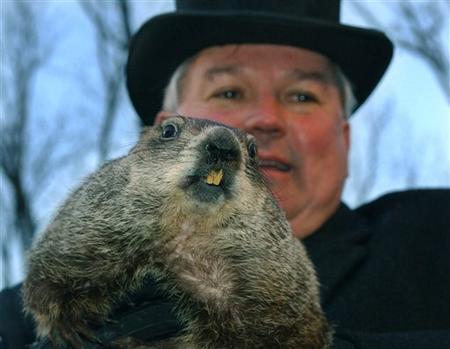
NO SHADOW: Look for an early spring
Obviously, it's more tradition than science. I mean, who would think a groundhog can predict the fate of winter better than a meteorologist? Let me re-phrase that question....
As the light grows longer
The cold grows stronger
If Candlemas be fair and bright
Winter will have another flight
If Candlemas be cloud and snow
Winter will be gone and not come again
A farmer should on Candlemas day
Have half his corn and half his hay
On Candlemas day if thorns hang a drop
You can be sure of a good pea crop
 I won't even begin the translation, because I don't speak Scottish (ha!). There have been many famous Groundhogs through the years. Here's a list from Wikipedia. I'd like to add at the bottom, "Petie" found under the weather deck last August. He predicted all our vegetables would be eaten before the end of the summer. Turns out...he was right.
I won't even begin the translation, because I don't speak Scottish (ha!). There have been many famous Groundhogs through the years. Here's a list from Wikipedia. I'd like to add at the bottom, "Petie" found under the weather deck last August. He predicted all our vegetables would be eaten before the end of the summer. Turns out...he was right.Punxsutawney Phil found in Punxsutawney, Pennsylvania
Wiarton Willie found in Wiarton, Ontario
Staten Island Chuck found in New York City, New York
General Beauregard Lee, PhD found in Atlanta, Georgia
Malverne Mel and Malverne Melissa found in Malverne, New York
Brandon Bob of Brandon, Manitoba
Balzac Billy of Balzac, Alberta
Shubenacadie Sam of Shubenacadie, Nova Scotia
Gary the Groundhog of Kleinburg, Ontario
Spanish Joe of Spanish, Ontario
Sir Walter Wally of Raleigh, North Carolina
Pardon Me Pete of Tampa, Florida
Jimmy the Groundhog of Sun Prairie, Wisconsin
Octoraro Orphie of Quarryville, Pennsylvania
If you'd like to visit the official Groundhog day history site CLICK HERE. Otherwise, we all hope you have a Happy Groundhog Day! ---Meteorologist Brent Watts





